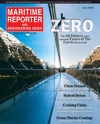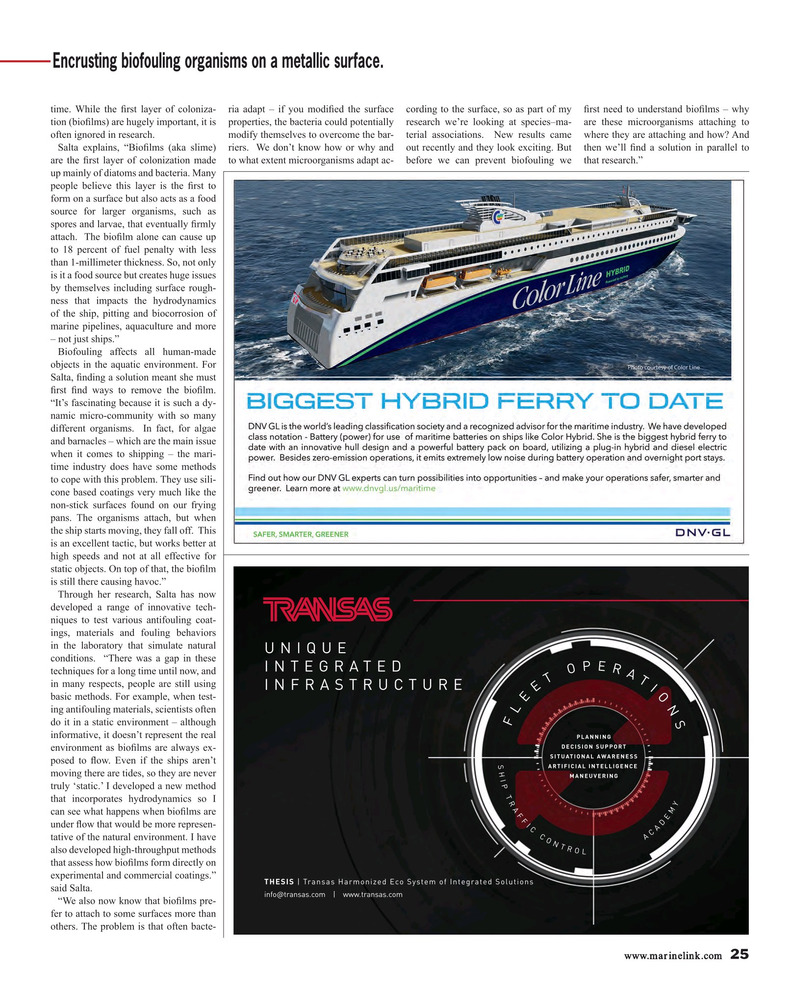
Page 25: of Maritime Reporter Magazine (June 2018)
Green Marine Technology
Read this page in Pdf, Flash or Html5 edition of June 2018 Maritime Reporter Magazine
Encrusting biofouling organisms on a metallic surface.
time. While the ? rst layer of coloniza- ria adapt – if you modi? ed the surface cording to the surface, so as part of my ? rst need to understand bio? lms – why tion (bio? lms) are hugely important, it is properties, the bacteria could potentially research we’re looking at species–ma- are these microorganisms attaching to often ignored in research. modify themselves to overcome the bar- terial associations. New results came where they are attaching and how? And
Salta explains, “Bio? lms (aka slime) riers. We don’t know how or why and out recently and they look exciting. But then we’ll ? nd a solution in parallel to are the ? rst layer of colonization made to what extent microorganisms adapt ac- before we can prevent biofouling we that research.” up mainly of diatoms and bacteria. Many people believe this layer is the ? rst to form on a surface but also acts as a food source for larger organisms, such as spores and larvae, that eventually ? rmly attach. The bio? lm alone can cause up to 18 percent of fuel penalty with less than 1-millimeter thickness. So, not only is it a food source but creates huge issues by themselves including surface rough- ness that impacts the hydrodynamics of the ship, pitting and biocorrosion of marine pipelines, aquaculture and more – not just ships.”
Biofouling affects all human-made objects in the aquatic environment. For
Salta, ? nding a solution meant she must ? rst ? nd ways to remove the bio? lm. “It’s fascinating because it is such a dy- namic micro-community with so many different organisms. In fact, for algae and barnacles – which are the main issue when it comes to shipping – the mari- time industry does have some methods to cope with this problem. They use sili- cone based coatings very much like the non-stick surfaces found on our frying pans. The organisms attach, but when the ship starts moving, they fall off. This is an excellent tactic, but works better at high speeds and not at all effective for static objects. On top of that, the bio? lm is still there causing havoc.”
Through her research, Salta has now developed a range of innovative tech- niques to test various antifouling coat- ings, materials and fouling behaviors in the laboratory that simulate natural
UNIQUE conditions. “There was a gap in these
E
P
INTEGRATED
R
O techniques for a long time until now, and
A
T
T in many respects, people are still using
INFRASTRUCTURE
I
E
O basic methods. For example, when test-
E
N ing antifouling materials, scientists often
L
S do it in a static environment – although
F informative, it doesn’t represent the real
PLANNING
DECISION SUPPORT environment as bio? lms are always ex-
SITUATIONAL AWARENESS posed to ? ow. Even if the ships aren’t
S
ARTIFICIAL INTELLIGENCE
H moving there are tides, so they are never
MANEUVERING
I P T truly ‘static.’ I developed a new method that incorporates hydrodynamics so I
R
Y
A
M can see what happens when bio? lms are
F
E
F I C C
D under ? ow that would be more represen-
A
C
A tative of the natural environment. I have
O
N
T
R
O also developed high-throughput methods
L that assess how bio? lms form directly on experimental and commercial coatings.”
THESIS | Transas Harmonized Eco System of Integrated Solutions said Salta.
[email protected] | www.transas.com “We also now know that bio? lms pre- fer to attach to some surfaces more than others. The problem is that often bacte- www.marinelink.com 25
MR #6 (18-25).indd 25 MR #6 (18-25).indd 25 6/7/2018 3:18:21 PM6/7/2018 3:18:21 PM

 24
24

 26
26
